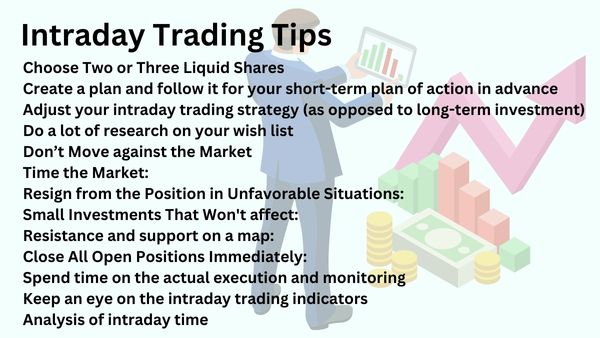Intraday Trading Tips, Strategies & Basic Rules

Intraday Trading Tips- Compared to investing on the normal stock market, intraday trading is riskier. Due to the high volatility of the stock markets, most traders—especially novices—lose money when engaging in intraday trading.
Convention dictates that in order to maintain proper risk management in intraday trading, one should not risk more than 2% of their whole trading capital on a single trade. The risk of ignorance is bigger than the market risk itself, thus it’s important for newcomers, in particular, to understand the fundamentals of this type of trading to prevent losses.
Intraday Trading Tips
Below are a few tips for intraday trading in Indian share market which will help investors in making the right decision:
Choose Two or Three Liquid Shares
Before the trading day is over, open positions are squared in intraday trading. It is advised to pick two or three highly liquid large-cap equities because of this. Due to the low trading activity of mid-size or small-cap stocks, investors may have to hold onto their shares.
Create a plan and follow it for your short-term plan of action in advance
The following are major elements of a short-term trajectory:
- Set your desired price and entry level in advance. After buying the shares, a person’s psychology frequently changes. So even if the price slightly rises, you may still sell. As a result, you can miss out on the chance to benefit from bigger gains brought on by the price increase.
- Once the goal has been attained, book your gains. Uninformed greed may cause you to hold onto a stock longer than is necessary, increasing the danger of a price decline. Make sure to update a stop-loss price to reflect the revised expectations if you insist on continuing.
A stop loss trigger is used to immediately sell the shares if the price drops below a certain threshold. Stop loss minimises loss for investors who have employed short selling in the event that the price rises more than they had anticipated.
Adjust your intraday trading strategy (as opposed to long-term investment)
Fundamentals are adopted by value investments while technical details are taken into account by the former. Day traders frequently take delivery of shares in the event that the target price is not reached. Then, in order to get his or her money back, he or she waits for the price to increase. This is not advised because the stock could not be suitable for investment given that it was only bought for a brief period of time.
Do a lot of research on your wish list
Investors are urged to thoroughly investigate 8 to 10 shares on their wish lists. It’s crucial to understand the technical details of company events like mergers, bonus deadlines, stock splits, dividend payments, etc. It will also be helpful to use the Internet to determine the levels of support and opposition. Of course, learning the terminology and foundational ideas of the stock market is vital.
Don’t Move against the Market
Market moves cannot be predicted, not even by skilled experts using cutting-edge instruments. There are instances when every technical indicator points to a bull market, but there may still be a drop. These variables merely serve as a guide and offer no assurances. To prevent severe losses, it’s crucial to close out your position if the market behaves differently than you anticipated. Intraday trading uses more leverage, which effectively results in respectable profits in a single day. To be a successful day trader, you must be content.
Time the Market:
Experts frequently advise people to stay away from trading within the first hour after the markets open.
Resign from the Position in Unfavorable Situations:
It is important to record the profits and close the open position for trades that result in profits and price-give reversal (price anticipated to display reverse trends). Additionally, it is advised to quit the trade right away rather than waiting for the stop-loss trigger to be activated if the circumstances are not favourable. Trades will lose less money as a result of this.
Small Investments That Won’t affect:
It happens frequently for new traders to lose control after seeing some success with day trading. Markets are unstable, though, and even for seasoned experts, forecasting trends is difficult. Beginners risk quickly losing all of their investments in such circumstances.
Because of this, a key intraday tip is to only invest amounts that the customer can afford to lose. In the event that the markets are not in their favour, this will ensure that people do not have financial issues. To maintain proper risk management, traders should not risk more than 2% of their whole trading capital on a single trade.
Resistance and support on a map:
From the first 30 minutes of the trading session, also referred to as the opening range, every stock price moves within a certain range. The resistance and support levels are thought to be the highest and lowest prices during this time. It is recommended to buy shares when they rise above the opening range high and to sell them if they decline below the opening range low.
Close All Open Positions Immediately:
If their goals are not met, some traders can be tempted to take delivery of their positions. This is one of the worst mistakes, and even if traders must report a loss, it is essential to close all open positions. By not closing, the trader is subject to overnight risk (eg: market crash in USA or Europe)
Spend time on the actual execution and monitoring
Day trading is not appropriate for professionals with full-time jobs. To be able to make the necessary decisions, traders must be able to track market movements throughout the whole trading session (from the opening bell to the closing bell).
Keep an eye on the intraday trading indicators
You will need to conduct a lot of study if you want to book profits in intraday trading. You must adhere to specific indicators in order to achieve the same goal. Intraday advice are frequently regarded as the Holy Grail, however this is not totally true. In order to maximise results, intraday trading indicators are useful tools when combined with a thorough plan.
Analysis of intraday time
Daily charts are the most frequently used charts to illustrate price fluctuations over a one-day period in intraday trading. These charts, which are a common intraday trading strategy, assist show how prices change from the opening bell to the end of the daily trading session. Charts for intraday trading can be used in a variety of ways. The charts that are most frequently used during intraday trading on the Indian stock market are listed below.
How to Choose Stocks for Intraday Trading
It’s crucial to understand how to choose stocks for intraday trading if you want to be successful as a day trader. People frequently struggle to turn a profit because they choose the wrong stocks to trade. If day trading is not properly managed, it can drastically affect individuals’ financial well-being.
Trading can be enticing due to the potential for significant returns in a short amount of time. However, intraday trading might be hazardous if you don’t comprehend it or have enough information.
Intraday traders are constantly exposed to the hazards that come with trading stocks. The equities chosen for daily trading are influenced by a number of factors, including price volatility and changing daily volume.
Here are some effective intraday trading methods to use in order to manage the risk taken while generating larger returns:
ORB: Opening Range Breakout
Both professional traders and novice traders frequently employ this intraday trading method. This technique should be used in conjunction with strict regulations, optimal indicator use, correct market sentiment evaluation, and accurate market sentiment analysis to maximise its potential.
There are several versions of ORB; some traders might choose to trade on significant breakouts from the opening range, while others would decide to do so on the opening range breakout. The transaction window is between 30 minutes and three hours long.
Demand-Supply Imbalances:
Beginners should look for companies with significant demand-supply imbalances and use those as entry points when trading intraday. The financial markets adhere to the standard norms of supply and demand: when there is no demand for increased supplies, pricing decreases, and vice versa. Through investigation and analysis of previous price movements, users must learn to recognise these places on the price chart.
Choose a risk-to-reward ratio of 3:1:
Beginners in trading, in particular, need to comprehend the proper risk-reward ratio. Finding stocks that have a potential risk-reward ratio of at least 3:1 will initially help investors make money on the stock market. Even if they lose money on the majority of their trades, this technique will still give them the chance to make large gains.
Use the Average Directional Index (ADX) and Relative Strength Index (RSI):
To locate buy and sell chances, traders might achieve success by combining these two intraday trading tactics. A technical momentum indicator called the RSI compares recent losses and gains to identify overbought and oversold equities. The ADX is useful for identifying when prices are exhibiting strong trends.
In most cases, when the RSI crosses over the upper limit, a sell transaction is indicated, and vice versa. In contrast, intraday traders purchase when the RSI reaches the upper limit and vice versa when the RSI and ADX are combined. In order to assist consumers in making purchase or sell choices, the ADX is utilised as a trend indicator.
Conclusion
The same-day trade settlements involved in intraday trading. Most traders aim to make modest profits from their trades. The best intraday advice is to profit by following the market trend.
- Have a plan: Before entering any trade, have a clear plan in place, including entry and exit points, stop loss levels, and profit targets.
- Keep an eye on market news and events: Stay informed about market news and events, as they can have a significant impact on stock prices.
- Use technical analysis: Use technical indicators such as Moving Averages, RSI, and MACD to identify trends and momentum in the market.
- Focus on liquidity: Look for stocks with high trading volume and liquidity, as they are more likely to experience price movements during the day.
- Keep an eye on overall market trends: Be aware of overall market trends, such as sectoral indices, stock market sentiments, and global market conditions.
- Limit your risk: Always use stop loss orders to limit your potential losses and protect your capital.
- Don’t overtrade: Avoid overtrading, which can lead to impulsive and emotional trading decisions.
- Be disciplined: Follow your trading plan and be disciplined in sticking to it.
- Keep learning: Keep learning about new trading strategies, tools, and market trends to improve your skills and knowledge as a trader.
- Have patience: Don’t expect to make a profit on every trade, have patience, and be persistent in your approach to trading.
Remember that intraday trading is a high-risk activity and it’s important to have a good understanding of the market before starting to trade. It is also important to have a good risk management plan in place and to keep your emotions in check.
Related article– Investing Mistakes the Ultra Wealthy Don’t Make
Charts and portfolio watch features of Angel One’s Angel Eye assist in spotting trends, enabling traders to make wiser decisions. This will make it easier for traders to profit from intraday trading.




